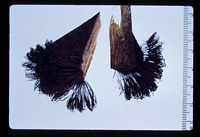|
 Stemonitis splendens Stemonitis splendens
BiostatusPresent in region - Indigenous. Non endemic
Images (click to enlarge)
Owner: Herb. PDD |
Article: Stephenson, S.L. (2003). Myxomycetes of New Zealand. Fungi of New Zealand. Ngā Harore o Aotearoa 3: xiv + 238 p. Hong Kong: Fungal Diversity Press.
Description: Fruiting body a stalked sporangium, often forming large clusters, 7–15 mm tall. Sporotheca cylindrical, deep purplish brown to black, obtuse, rigid and more or less erect in the shorter clusters, ranging to flexuose and acuminate in the longer fruitings, sometime agglutinated, up to 0.5 mm in diameter. Stalk black, polished, 1–4 mm tall. Hypothallus membranous, silvery or somewhat purplish. Peridium fugacious. Columella reaching nearly to the apex, often coiled and tortuous toward the tip. Capillitium brown, often with notable coppery or bronze iridescence, arising from the columella by relatively few branches, the meshes open and the tips united with the large-meshed surface net, the meshes irregular and mostly 20–100 µm in diameter, the net incomplete or lacking in agglutinated fruitings. Spores purplish black in mass, yellowish or lilaceous brown by transmitted light, faintly or rarely prominently warted, 7–9 µm in diameter. Plasmodium pale yellow or white.
Habitat: Decaying wood. It is often common on old, decaying logs of radiata pine
Distribution: Reported as cosmopolitan (Martin & Alexopoulos 1969) but probably more or less limited to temperate and tropical regions of the world. First reported from New Zealand by Cheesman & Lister (1915), based on a specimen collected in the Bay of Plenty. Also known from Three Kings Islands, Auckland, Waikato, Nelson, Buller, South Canterbury, and Dunedin.
Notes: The distinguishing features of this species are the large overall size of the sporangia and the large meshes of the surface net.
|